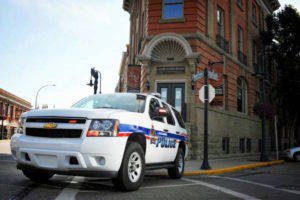Lacombe remains a safer community in comparison to many of neighbouring communities according to Maclean’s magazines’ annual Canada’s Most Dangerous Places list.
The city currently sits 77th out of 237 communities on the list — with Wetaskwin in third Red deer coming in 6th, Lethbridge in 19th, Sylvan Lake in 29th, Edmonton 27th and Calgary in 80th.
“I think overall it would indicate Lacombe is a safe community,” Lorne Blumhagen, Lacombe Police Service (LPS) chief of Police, said. “We aren’t immune from crime and social issues that other communities face, but we are doing quite well as a community.
“As a police service, we are maintaining a good level of public safety, but we still have work to do.”
The study by Maclean’s compares changes in the Crime Severity Index,which takes into consideration both the volume and seriousness of offences. since 2012.
Lacombe currently has CSI of 83, which is above the national average of 70.96 — good for 77th out of 237 communities.
Lacombe’s violent CSI currently sits at 35, which is significantly below the national average of 75.25 and places the city 180th out of 237 communities.
“When you look at violent crime ranking for Lacombe, we are very low — which is excellent and we want to maintain that. It is really our property crime numbers that keeps our ranking higher,” Blumhagen said.
Blumhagen credits Lacombe’s ranking to their 24-hour municipal policing model, which is different than many jurisdictions in the province that use RCMP detachment models.
“The timeliness of receiving calls and responding have been to our benefit,” he said. “Having localized dispatch allows our citizens to know that when they phone in, they are going to be answered in a timely fashion. They will get a response within minutes. Geographically it helps that we aren’t responding long distances, but we do have the ability in our model of 24 hr policing and minimum staffing models that we do have the resources.
“If we are tied up on other calls, we will still get to any call within a reasonable period of time.”
LPS has also been continually relying on a focus on repeat offenders to help limit property crime in the city.
“We do have a high number of property crimes and a lot of those property crimes are being committed by the same individuals,” Blumhagen said. “One person in one night can enter numerous vehicles or commit multiple thefts that are reported the next day.
“We don’t have abundance of people committing those offences, but if you can identify individuals and deal with them — usually your numbers will go down.”
In order to identify individuals, Blumhagen and his team rely on the community reporting each crime which allows LPS to collect analytical data.
“Our community is very apt to report incidents and we encourage them to report more often in a timely matter,” he said. “Many people forget we are open 24 hours and forget to report. They can phone at 3 a.m. if they see something suspicious and we can respond.
“We have a philosophy of ‘No call too small’ and we will attend all the complaints we receive and try to investigate those to the best of our ability.”
What consistent reporting can do is lead to higher statistics, which can be misleading if taken solely on face value. Blumhagen suggested that sometimes if reported property crime statistics are higher, it actually means that LPS has been able to respond to them due to the community reporting incidents.
LPS has also upped the amount of communication they have with other jurisdictions in order to target regional offenders, who are often very mobile according to Blumhagen.
“We have made improvements in the area of intelligence sharing working with the CISA (Criminal Intelligence Service of Alberta). We are strengthening our partnerships and attending meetings with other agencies on a regular basis,” he said.
Overall, Blumhagen says the Maclean’s report shows that LPS is moving in the right direction but there is plenty more left to be done.
“We are trying to become the safest community in all of Canada, but we have to be realistic about that as well,” he said.
More information, the study can be found at https://www.macleans.ca/canadas-most-dangerous-places-2019/.
todd.vaughan@lacombeexpress.com
Like us on Facebook and follow us on Twitter

